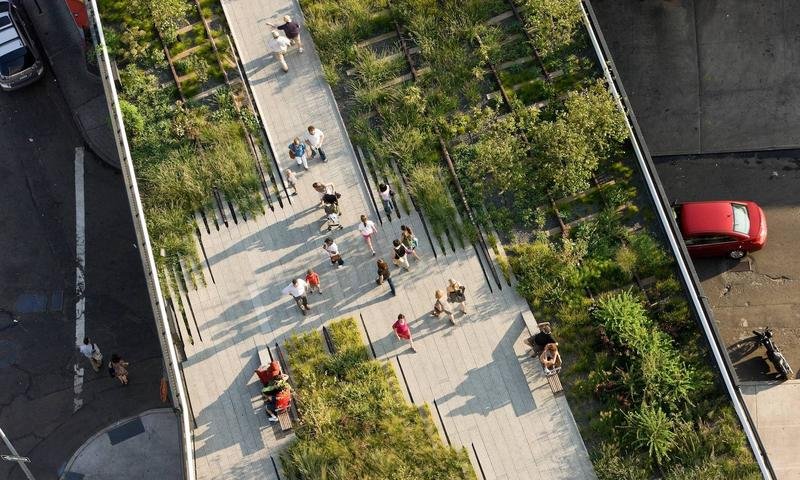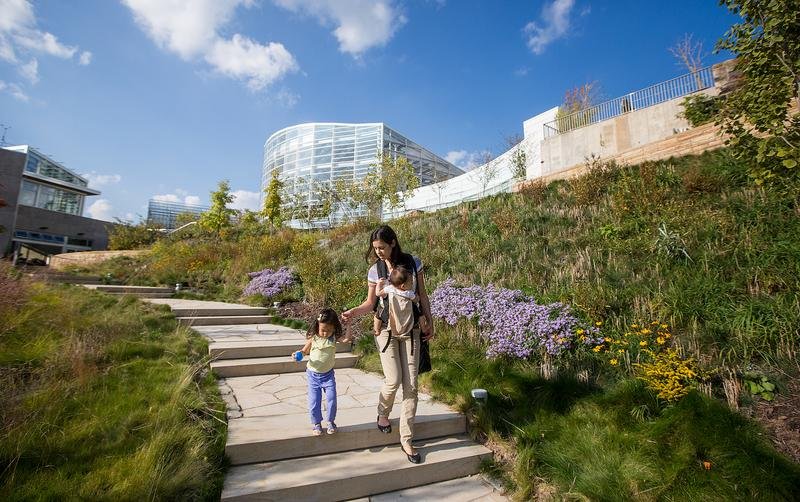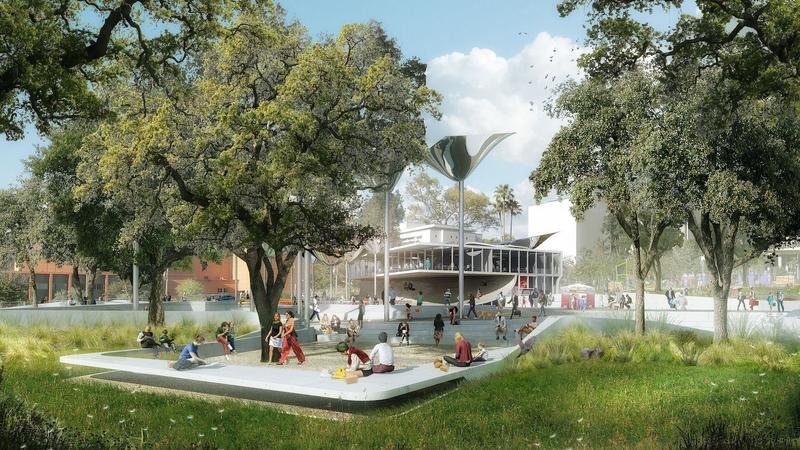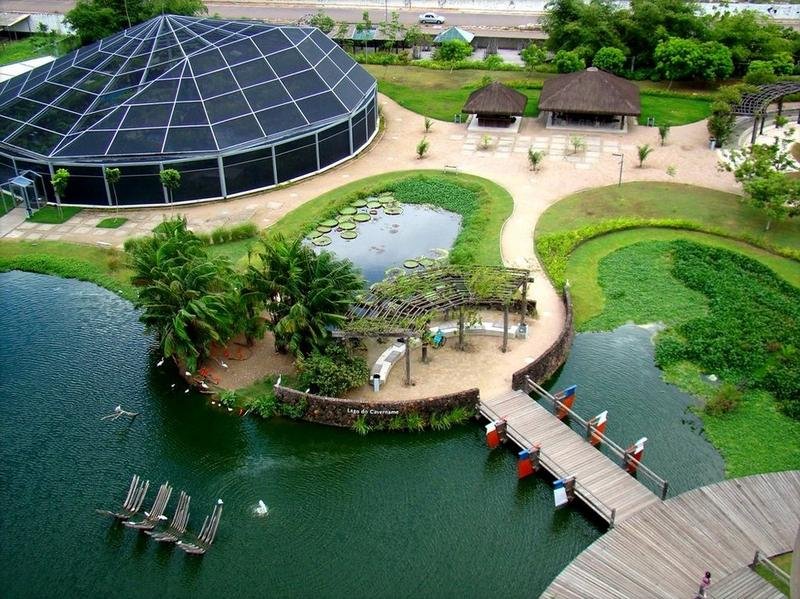Introduction
by Baktaash Sorkhabi
Landscape architect profiles by Brian Addison
The vernacular of Latinx/Latino urbanism is not defined by any specific architectural style or form but more about the traditions and activities that Latinos bring when adapting and reclaiming the existing built environment.
While the typical American suburb is structured to separate and zone land for separate and often single uses, homes in Latin America tend to be in mixed-use neighborhoods; the deemphasized distinction between the public and private realm reflecting a cultural, social, and economic life centered around the zocalo, or plaza.
For many communities of color, neighborhoods are more about social cohesion than they are just property values.
In The United States, some Latino neighborhoods with single-family homes are repurposed to enable those types of private-public interactions that are common back home: A front yard might be fenced in to move the private home space closer to the edge—so a neighbor on the sidewalk can easily meet and interact with people from the house, similar to the interior courtyards of homes in Mexico.
A vacant lot, old gas station, or otherwise empty stretch of sidewalk can easily transform into a bustling pop-up node of commerce: This type of street vending—ranging from a single food cart to small pedestrian-oriented, commercial district where tents line a street or row—is often tactile and more energetic and vibrant than the mass counterparts found in wealthier parts of a city. (Counterparts, mind you, that ironically attempt to mimic the very intimacy of these street vendors only to come off as upscale and inaccessible to the very people who created the desire for mimicry.)
In Southern California, Latino Urbanism is perhaps the strongest force of change for improving mobility and creating a pedestrian friendly city. Many Latinos in working-class neighborhoods don’t have cars and the reframe the built environment around them to support their mobility needs.
While a traffic engineer is fixated on time and speed, Latino mobility interventions are based on the memory, needs, and aspirations of the community and can informally transform auto-centric streets into places that nurture human interaction and cultural expression.
In this spirit, we want to introduce five Latino urban creators who are helping Hispanic, Latino, and Latinx communities across the country and hemisphere find their voices.

Mia Lehrer of El Salvador
President at Studio-MLA
We begin with one of our own: Though born in El Salvador, Los Angeles and its surrounding region is where Mia Lehrer has made her largest mark. We’re talking the Hollywood Park Racetrack redevelopment and its new SoFi Stadium and associated public parks, the LA County Natural History Museum Gardens, the Lucas Museum of Narrative Art, the proposed park at First and Broadway in DTLA…
Her biggest project? The L.A. River revitalization project, a 32-mile stretch that criss-crosses through a diverse array of communities and neighborhoods. But the one thing that connects them all? Being in Los Angeles—and it is her pride in being Latin-American that she harnesses the power of our region:
“Within Latin American culture, there is a strong sense of family and multi-generational connectedness and creating networks. Spanish is my native tongue and there is a natural camaraderie on construction sites, in the halls of government buildings, and among environmental leaders. Being a Latina has provided me both with an outsider and insider view of the city of Los Angeles. I am from somewhere else however with such a strong Latino presence in the city I was able to engage in a deeper understanding of the issues facing a lot of the communities and facilitate communication between different groups.”

José Almiñana of Venezuela
Principal at Andropogon
This landscape architect is internationally recognized for his non-invasive and minimal approach to the landscape that seeks to preserve and highlight the site’s existing ecology—or, in his own words:
“One thing that I realized from the very beginning was that people are part of the ecology. People are part of the system. People are part of nature. There’s no dichotomy, no us-and-them, between nature and human beings. But we are agents of change. And professionally, landscape architecture has this amazing capacity to really think about the world in a very comprehensive way.”

Isabel Castilla of the United States
Principal at James Corner Field Operations
The influence of Puerto Rican-American Isabel Castilla’s work has reached across the nation thanks in large part to her involvement in one of the most influential pieces of park design in the wester hemisphere, the High Line in New York City. Once an aging, out-of-operations rail track that sat above grade and was set to be demolished, Castilla joined a leadership that opted to adaptively reuse the structure in order to create some much needed park space in the neighborhood.
The park’s influence cannot be overstated, inspiring and influencing everything from Atlanta’s Beltline to Chicago’s 606 parks.
Her latest project follows in this same vein and proves even bigger: She leads the landscaping for Miami’s 10-mile, $120M Underline Linear Park that takes over the un-utilized space beneath the city’s Metrorail. The first portion of the park opened in 2020.

Rosa Grena Kliass of Brazil
Founder and principal at Rosa Grena Kliass Landscape Planning and Projects, Ltd.
Arguably one of the most influential Latinas in the history of the field, Rosa Grena Kliass arose in a time when women were not to be in the yard nor were they to build things—but shortly after graduating with a degree in architecture from the University of São Paulo in 1955, she opened up her own firm in 1958.
Her influence is felt throughout Brazil: The Mangal das Garças in Belém shows off her ability to not just work within an Amazonian ecosystem, tying lagoons together that empty into mangroves, but flex her design skill.
Her most powerful work can be witnessed at the Parque da Juventude in São Paulo. A piece of of both grandeur and youth—needed given the park’s moniker—the park’s presence marks a distinct counterpoint to what it once was: a prison—and a very violent one at that. Using the abandoned steel structures left behind when the prison closed, the space is now one of the city’s most popular public spaces.

Roberto Burle Marx of Brazil (1909-1994)
Founder and former principal at Burle Marx & Cia. Ltda.
We end with a history that, at least in terms of the human who led it, has moved past its earthly life but whose influence is one of the strongest in the field.
One would be hard pressed to say that Roberto Burle Marx didn’t inspire, in one capacity or another, the work of the aforementioned landscape architects—for what Burle Marx achieved was elevating landscape architecture into art, where his strength as a modern expressionist were inherently intertwined with his ability to look at large spaces and think of them differently.
This year marked a particularly important milestone in Burle Marx’s legacy: His Sítio Roberto Burle Marx—formerly named the Sítio de Santo Antonio da Bica, a property he acquired in 1949 on the outskirts of Rio de Janeiro—has been formally inscribed into the UNESCO World Heritage List because of its “unique Modernist design and its importance for environmental and cultural preservation.”


